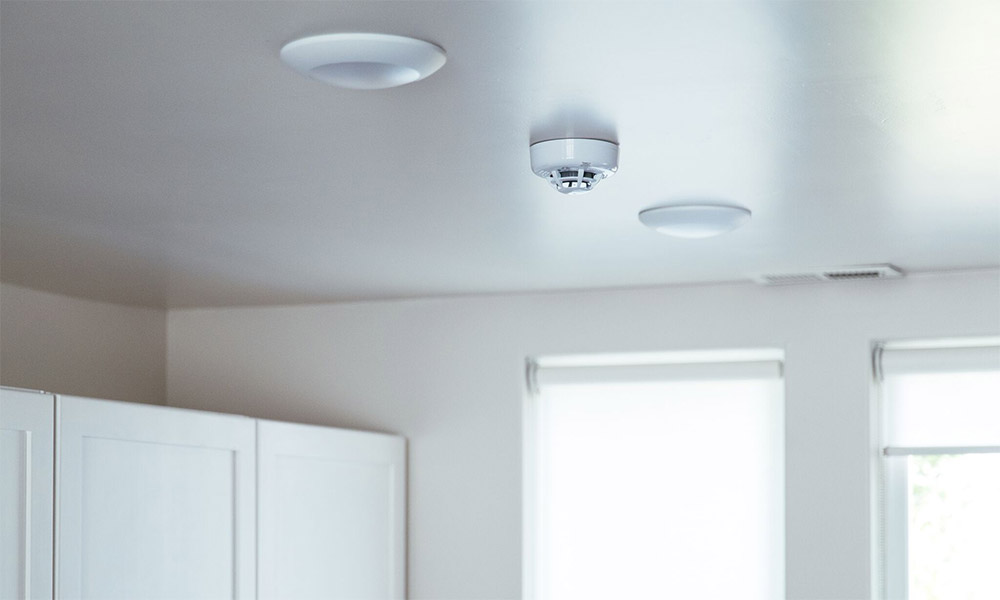Protecting your home against fire. It’s nothing to be taken lightly. Do you know what’s available in smoke detector technology, and have you taken the time to fortify your home against fire?
Whether you have smoke detectors installed, you have them, and your batteries are low, or your home is currently without them, here’s what you need to know about these life-saving devices.
Heat detectors: the original smoke alarms
The oldest form of fire-detection device is a heat detector. It functions simply with a detection element inside the device that activates when it reaches a fixed temperature or an extreme increase in temperature occurs.
Heat detectors may be ideal only if speed in sensing smoke and fire is not of great concern, or if space is small and confined where fast-burning, high-heat fires are likely to occur. But neither of these scenarios lends itself to residential fire protection.1
So when you think of safeguarding your home against fire, forget heat detectors. Smoke detectors are where it’s at.
They’re going to sense the presence of extreme heat, smoke, and fire faster than a heat detector. And they’ve proven much more effective in detecting fires in residential homes.2 If you don’t have smoke detectors installed in your home, get them. If you have them, make sure they’re in working order, and batteries are kept current.
How do smoke detectors work and how do you choose what’s right for your home?
OK. We know we need smoke detectors. But do you have any idea how they actually work?
If the answer is no, not to worry. You’re in the majority. Most people aren’t aware of how, exactly, a smoke detector does its job. But just in case you’re curious how these life-saving devices work, we’re here to tell you.

Ionization vs. photoelectric smoke detectors
Aside from heat detectors, you have three options when it comes to smoke detectors: ionization, photoelectric, or a combination of the two. Let’s take a look:
Ionization smoke alarms
These smoke detectors are much more responsive to fast, raging fires and flames. They contain a small amount of radioactive material that passes between two electrically charged plates, which create an ionization chamber. This configuration ionizes the air and creates a current that flows between the plates. If smoke enters that space, it absorbs alpha particles and disturbs the ionization process, which reduces the current and activates the alarm.
Photoelectric smoke alarms
These types of detectors typically respond better to smoldering fires—essentially those that begin with a long period of smoldering. Photoelectric alarms work using a photoelectric sensor and a light source. As smoke enters the chamber and crosses the path of the light beam, light is scattered by the smoke particles, aiming it toward the sensor, which in turn triggers the alarm.
For best protection, use both types of smoke alarm technologies
Combination smoke detectors utilize both technologies—ionization and photoelectric. With the capabilities of both in place, you increase your chances of being alerted to fire and protecting your family should this type of emergency arise. In fact, The National Fire Protection Agency (NFPA) recommends using both technologies to get the most protection for your home.3

Residential fires that result in fatalities, no matter what time of day, include both smoldering and flaming fires. And since it’s impossible to predict not only the occurrence of fire but also the type of fire that may strike, having both forms of smoke-detection technology is the way to go.
You’ll get the earliest warning signs possible, no matter what type of fire, what time of day, and whether you’re asleep or awake. And if you install detectors that come with a monitoring service, your home is protected even when you’re away—whether it’s quick, rapid flames or a fire that smolders for some time.
How to get the best smoke detection coverage for your home
So how do you go about accomplishing this?
If your existing alarms are photoelectric, you can purchase ionization detectors and place one beside each photoelectric unit. If you’re not sure what kind of detectors you’re dealing with, check your owner’s manual. Or just remove the smoke detector and look at the back—you’ll find either the word “photoelectric” or “ionization” or simply the initial letters of the words.
If it’s in the budget you could also consider replacing your smoke detectors altogether with combination units. These dual-sensor devices feature both ionization and photoelectric technologies working in tandem. With these units, you get the convenience and peace of mind of both types of technologies working together in a single device.
Smoke detector placement and operation procedures
Once you know what you need in terms of smoke detector technology, how do you determine how many detectors you need and where to place them?
According to the NFPA, detectors should be installed:
- inside every bedroom,
- outside each sleeping area, and
- on each level of the home.
Bigger homes will obviously need more fire alarms than smaller homes.4
If you install smoke detectors as part of a comprehensive smart home system, they can connect on a single platform so that when one alarm triggers, all of the smoke detector alarms in the house will sound. Notifications are sent to your system’s control panel and you’ll receive them on your mobile device as well.

If you opt for a Vivint Smart Home system, our monitoring and support specialists are always ready to hear the alarm—even when you’re not home—and contact emergency services when you can’t. This additional layer of security further protects your home and loved ones and offers you peace of mind no matter where you are.
Sources
1,2 – “Types Of Smoke Detectors And Alarms - Quick Tips #366 - Grainger Industrial Supply”. 2018. Grainger.Com.
3 – “Ionization vs photoelectric”. 2014. National Fire Protection Association.
4 – “Installing and maintaining smoke alarms”. 2018. National Fire Protection Association.
















